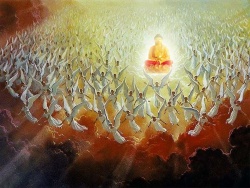Difference between revisions of "Mañjuśrīmūlakalpa"
| Line 4: | Line 4: | ||
The text, which is in a compilation of fifty -five chapters, provides detailed instructions by the Buddha on the performance of [[rituals]] and consecrations, including the important jar or [[vase consecrations]] ([[KALAŚĀBHIṢEKA]]). The work is also among the first to introduce the notion of families ([[KULA]]) of [[divinities]], in this case three families: th e [[TATHĀGATAKULA]], the [[PADMAKULA]], and the [[VAJRAKULA]]. Like other [[tantric]] texts, it provides instruction on a wide range of topics, including the {{Wiki|recitation}} of [[MANTRAs]], the drawing of images and [[MAṆḌALA]]s, and the [[nature]] of the [[VIDYĀDHARA]], as well as on [[astrology]], [[medicine]]. Among the many {{Wiki|prophecies}} in the text is the oft-cited {{Wiki|prophecy}} concerning [[NĀGĀRJUNA]], in which the Buddha states that four hundred y [[ears]] after his passage into [[PARINIRVĀṆA]], a [[monk]] named [[Nāga]] will appear, who will live for six hundred years. | The text, which is in a compilation of fifty -five chapters, provides detailed instructions by the Buddha on the performance of [[rituals]] and consecrations, including the important jar or [[vase consecrations]] ([[KALAŚĀBHIṢEKA]]). The work is also among the first to introduce the notion of families ([[KULA]]) of [[divinities]], in this case three families: th e [[TATHĀGATAKULA]], the [[PADMAKULA]], and the [[VAJRAKULA]]. Like other [[tantric]] texts, it provides instruction on a wide range of topics, including the {{Wiki|recitation}} of [[MANTRAs]], the drawing of images and [[MAṆḌALA]]s, and the [[nature]] of the [[VIDYĀDHARA]], as well as on [[astrology]], [[medicine]]. Among the many {{Wiki|prophecies}} in the text is the oft-cited {{Wiki|prophecy}} concerning [[NĀGĀRJUNA]], in which the Buddha states that four hundred y [[ears]] after his passage into [[PARINIRVĀṆA]], a [[monk]] named [[Nāga]] will appear, who will live for six hundred years. | ||
{{PrincetonDict}} | {{PrincetonDict}} | ||
| − | [[Category:]] | + | [[Category:Manjusrimulakalpa]] |
Latest revision as of 16:10, 1 January 2015
Mañjuśrīmūlakalpa. (T. ’Jam dpal gy i rtsa ba’i rgy ud; C. Dafangguang pusazang wenshushili genben y igui jing; J. Daihōkō bosatsuzō Monjushiri konpongikiky ō; K. Taebanggwang posalchang Munsusari kŭnbon ŭigwe ky ŏng; 大方廣菩薩藏文殊師 利根本儀軌經). In Sanskrit “The Fundamental Ordinance of MAÑJUŚRĪ”; known in Tibetan as the “Fundamental Tantra of Mañjuśrī.” The work is an early and important Buddhist TANTRA (marking a transition between the SŪTRA and tantra genres), dating probably from around the late sixth or early seventh centuries, which was later classed as a KRIYĀTANTRA.
The text, which is in a compilation of fifty -five chapters, provides detailed instructions by the Buddha on the performance of rituals and consecrations, including the important jar or vase consecrations (KALAŚĀBHIṢEKA). The work is also among the first to introduce the notion of families (KULA) of divinities, in this case three families: th e TATHĀGATAKULA, the PADMAKULA, and the VAJRAKULA. Like other tantric texts, it provides instruction on a wide range of topics, including the recitation of MANTRAs, the drawing of images and MAṆḌALAs, and the nature of the VIDYĀDHARA, as well as on astrology, medicine. Among the many prophecies in the text is the oft-cited prophecy concerning NĀGĀRJUNA, in which the Buddha states that four hundred y ears after his passage into PARINIRVĀṆA, a monk named Nāga will appear, who will live for six hundred years.
Source
The Princeton Dictionary of Buddhism by Robert E. Buswell Jr. and Donald S. Lopez Jr.
